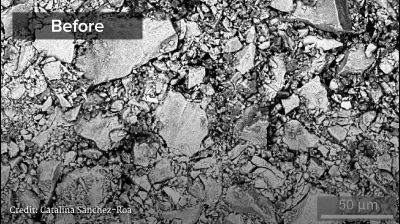As concentrations of atmospheric carbon dioxide (CO2) continue to rise and drive climate change, scientists have been researching options not just to reduce CO2 emissions but also to actually remove carbon from the atmosphere. Many carbon capture and storage methods seek to trap gaseous or water-dissolved CO2 in underground storage reservoirs, but these could leak and release greenhouse gas back into the atmosphere.
“When you inject CO2 in a gas form, it can escape, for example, if a fault is moving or there is damage to the reservoir. It is always going to be looking for a way to escape to an area where the pressure is lower,” explained Catalina Sanchez-Roa, an experimental geophysicist at Columbia University Climate School in New York City. “But with carbon mineralization, you [store] it as a mineral, as a solid, and then it’s very stably stored for a really long period of time.”
Cracking extended the duration of the reaction and enhanced the rock’s carbon storage capacity.
With mineral carbon storage, CO2 dissolved in water chemically reacts with rocks to form new minerals with the carbon. This process occurs all the time in nature and stores carbon within solid minerals for hundreds or thousands of years with little risk that it will escape back into the atmosphere. The downside? Storage capacity is limited. The carbonized water has to seep into the stone, but the mineralization process tends to clog up the pathways and reduce a rock’s permeability. Eventually, water can’t reach new surface areas to react with.
In new laboratory experiments, Sanchez-Roa tested how the permeability of dunite changed during a month of carbon mineralization. After an initial period in which mineralization clogged things up as expected, the mineralization created new fractures in the rock that exposed more reactive surface. The cracking extended the duration of the reaction and enhanced the rock’s carbon storage capacity. Sanchez-Roa presented these results at AGU’s Fall Meeting 2021 in December.
Make Way for Magnesite
To store carbon, a rock’s geochemistry has to be able to take the carbon from CO2 molecules and turn it into a mineral. Olivine minerals, which are common in igneous rocks, are very good at doing this. Carbon mineralization experiments focus on ultramafic, olivine-rich materials like basalt and dunite, which are found in land-based and seafloor deposits. For the purposes of carbon capture and storage, carbon mineralization is “just enhancing a process that happens naturally in many parts of the world,” Sanchez-Roa said.
In her experiments, Sanchez-Roa first created a dunite aggregate made from natural rocks that had been ground down to a known grain size, which made for more controlled testing. She injected the samples with carbonized water and monitored their permeability by precisely measuring fluid flow. Some experiments lasted only 4 days, and others went as long as 35 days.
The dunite’s olivine (Mg2SiO4) reacted with the injected CO2 to form silica (SiO2) and magnesite (MgCO3). At the beginning, the carbonized minerals began clogging up the rock and reducing permeability. But because the end products took up more volume than the original material, the magnesite and the silica ran out of empty space inside the rock even as new crystals kept forming. The carbonate minerals started pushing outward, trying to create more room to fit, and ultimately created cracks in the dunite sample.

“Even though the permeability was really low already, [cracking] kept some fluid going through it,” Sanchez-Roa said. “And it kept cracking, which means that some of the reaction was still happening and some of the CO2 was being captured.” The rock actually became more slightly more permeable for a short while, which was interpreted as fractures being created. The increased permeability meant that the sample could mineralize more carbon than it could have without the cracking. To see the carbon reaction continue after 35 days “is pretty amazing. It is the first time that we have seen the cracking happening in experiments.”
This work “contributes to answering a critical question: Is underground CO2 storage safe?” said Amir Jahanbakhsh, a petroleum reservoir engineer at Heriot-Watt University in Edinburgh, U.K. Jahanbakhsh was not involved with this research. “We need to integrate petrophysics, geomechanics, and geochemistry to understand petrophysical and mechanical changes of porous media as a result of chemical reactions happening due to CO2 injection.”
Scaling It Up
Some field testing of carbon mineralization in basalt is already ongoing, but there is still a lot of research needed into how well the process works with different types of stone and under various conditions before it can be engineered into a large-scale carbon storage solution.
“It is essential to understand the geochemistry of the system first.”
When selecting sites for in situ mineralization, “it is essential to understand the geochemistry of the system first,” Jahanbakhsh said. “We need to investigate whether these mechanisms have altered the petrophysical and mechanical properties of the storage medium to conclude that CO2 storage is safe for a site of interest.”
To that end, Sanchez-Roa’s future experiments will explore dunite mineralization at different temperatures, with natural unprocessed rocks instead of aggregates, and with a focus on the solid products that are produced. “We’re finding new things every time that we do an experiment,” she said. “And now we’re hoping to find a way to optimize this process so we can help implement more pilot projects around the world.”
—Kimberly M. S. Cartier (@AstroKimCartier), Staff Writer

